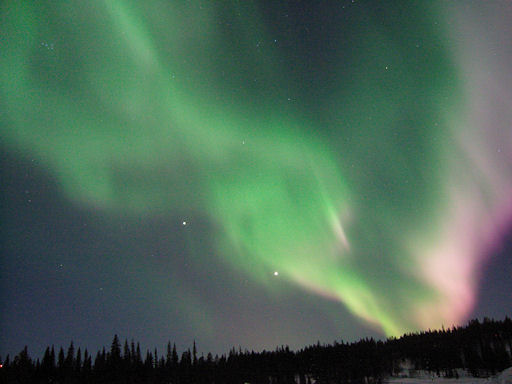Metallic photos of the sun by renowned photographer Greg Piepol bring together the best of art and science. Buy one or a whole set. They make a stellar gift. | | |
FLYING THROUGH A GEOMAGNETIC STORM: Lately, the International Space Station has been flying through geomagnetic storms, giving astronauts a close-up view of the aurora borealis just outside their windows. ISS Flight Engineer Don Pettit shares the experience in a new video from Science@NASA.
FIRST AURORAS OF MARCH: A magnetic disturbance rippled around the Arctic Circle during the waning hours of March 1st, sparking bright auroras just as night fell over northern Europe. "The show was stunning and amazing," says Thomas Albin, who sends this picture from Esrange, Sweden:

"There were three different colors visible and the dynamics of the lights were incredible!" he says.
A medium-speed solar wind stream is buffeting Earth's magnetic field. By itself, this was not enough to explain what happened. The extra ingrediant was the IMF: the interplanetary magnetic field near Earth tilted south, opening a crack in our planet's magnetosphere. Solar wind poured in and fueled the display.
NOAA forecasters estimate a 15% to 25% chance of polar geomagnetic storms during the next 24 hours. High-latitude sky watchers should remain alert for auroras. Aurora alerts: text, phone.
more images: from Peter Rosén of Kiruna, Swedish Lapland; from Chad Blakley of Abisko Touriststation, Abisko National Park, Sweden; from Lee Petersen of Fairbanks, Alaska; from Timothy Boocock of Trysil, Norway;
BLUE FLASH: We've all heard of the green flash, the fleeting emerald light that sometimes appears just above the setting sun. Once thought to be a fable, the green flash was popularized by Jules Verne in his 1882 novel "Le Rayon Vert" (The Green Ray). Now it is generally known to be real.
But what of the even rarer blue flash? Turns out, that's real too. Peter Rosén photographed one from Stockholm, Sweden, on Feb. 29th:

"I was shooting the sunset when, suddenly, just as the sun was about to disappear behind the treetops, there was a mighty blue flash," says Rosén.
Blues flashes are formed in the same way as green flashes: a mirage magnifies tiny differences in the atmospheric refraction of red, green and blue light. Blue flashes are generally harder to see than green flashes, because blue flashes blend into the surrounding blue sky. When the air is exceptionally clear, however, the blue flash emerges.
Verne described the green flash as something "which no artist could ever obtain on his palette, a green of which neither the varied tints of vegetation nor the shades of the most limpid sea could ever produce the like! If there is a green in Paradise, it cannot be but of this shade, which most surely is the true green of Hope."
Ditto the blue.
February 2012 Aurora Gallery
[previous Februaries: 2011, 2010, 2009, 2008, 2007, 2006, 2004, 2003, 2002]

